As a nation, Nigeria has suffered the most devastating assaults in 2012 from the hands of the "peaceful" Jihadis of Islam. And this is not something new to the Nigerians and the people belonging to surrounding regions. Instead, it has history that goes paste hundreds of year. As Nigeria's Christians pick themselves up not only from heavily battered years, but also another tragic Christmas, let us review the prolonged history of Jihadi barbarism against Nigeria and neighbouring countries :
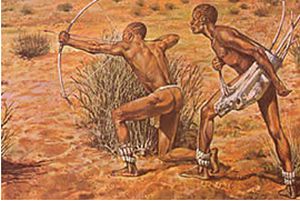 How the animistic tribes of Central Africa, Kenya, Tanzania, Ghana, Mauritania and Nigeria fell prey to the Jihadis. And how their struggle continues even today in the conflicts of the Muslims and Christians in Nigeria, Kenya, Tanzania, Ethiopia and Eretria, Somalia and between the Arabized Northern Sudanese with the Christian Dinka tribesmen of Southern Sudan and the Muslim but non-Arabized, darker-skinned tribesmen of Darfur who were forcibly converted to Islam late in the 18th century Areadi Gaya, the non-Muslim ruler of Futa Bandu State in West Sudan was forced to embrace Islam after he was defeated by the Mamelukes of Egypt.
How the animistic tribes of Central Africa, Kenya, Tanzania, Ghana, Mauritania and Nigeria fell prey to the Jihadis. And how their struggle continues even today in the conflicts of the Muslims and Christians in Nigeria, Kenya, Tanzania, Ethiopia and Eretria, Somalia and between the Arabized Northern Sudanese with the Christian Dinka tribesmen of Southern Sudan and the Muslim but non-Arabized, darker-skinned tribesmen of Darfur who were forcibly converted to Islam late in the 18th century Areadi Gaya, the non-Muslim ruler of Futa Bandu State in West Sudan was forced to embrace Islam after he was defeated by the Mamelukes of Egypt.
After overrunning Byzantine ruled Egypt and giving the Coptic Christian population the choice Islam, death or Jizya, the Muslim armies attempted to penetrate deeper into Africa from the 7th century onwards.
Central Africa was a poor semi-arid land with scrub vegetation, and there was nothing therein worth fighting for and holding the land and population under Muslim tyranny. As there were no major cities worth the name, and most of the population lived in migratory groups as hunter, food gatherers and cattle herders, there was precious little to tempt the invading Muslims by way of booty. Hence there was no sustained Muslim invasion of Africa proper. Muslim raids were confined to the Mediterranean coastline in the North and along the Nile Valley in Egypt.
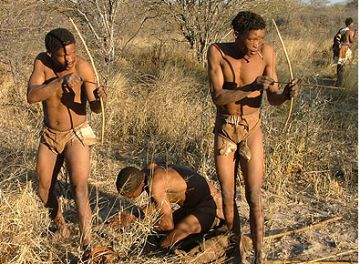 This also speaks the mind of the Muslims to raid non-Muslim lands not only for spreading Islam but to loot, plunder, rape. In the absence of any significant wealth, the lands were not subject to occupation, although there were continuing raids through the millennium from the 7th up to the 18th centuries. But during these raids the aggressors did use force to compel the African (Bantu, Bushmen, Masai and other Negro clans), to join the Muslim Ummah, by embracing Islam at the point of the sword as commanded by the Quran.
This also speaks the mind of the Muslims to raid non-Muslim lands not only for spreading Islam but to loot, plunder, rape. In the absence of any significant wealth, the lands were not subject to occupation, although there were continuing raids through the millennium from the 7th up to the 18th centuries. But during these raids the aggressors did use force to compel the African (Bantu, Bushmen, Masai and other Negro clans), to join the Muslim Ummah, by embracing Islam at the point of the sword as commanded by the Quran.
This difference was because the Muslims could not hold the converted African tribal populations to Islam, due to the victims being migratory in their utterly frugal and substance based lifestyle
Migratory Tribal populations living at sustenance levels dissuaded the Muslims from concentrating on Africa up to the 18th century
When the Jihadis attacked Central Africa, South Central Africa, up to the Atlantic shore in Ghana, the people of that region were divided in to independent tribes. Each tribe worshipped its own tribal god. Witchcraft and Shamanism were prevalent. Many of the tribes were engaged in internecine warfare for cattle, control over grazing pastures and hunting grounds. There was no unity among the tribes. And till the Mameluke led Muslim invasion, no invader had ever penetrated in to the heartland of Africa.
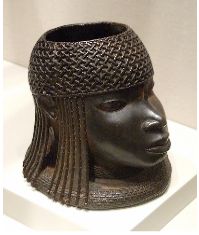 Before Islam destroyed them, there were developed black African civilizations like those of Benin, Ashanti, Zulu, Nubia, Axum and many others. These Black African kingdoms that existed in africa prior to the islamic invasion were culturally spiritually and technologically more advanced than the arab barbarians that invaded them as is evident from the pictures of the kings of Benin. Seen here is the Head of a courtier in the court of Benin Nigeria circa 1550.
Before Islam destroyed them, there were developed black African civilizations like those of Benin, Ashanti, Zulu, Nubia, Axum and many others. These Black African kingdoms that existed in africa prior to the islamic invasion were culturally spiritually and technologically more advanced than the arab barbarians that invaded them as is evident from the pictures of the kings of Benin. Seen here is the Head of a courtier in the court of Benin Nigeria circa 1550.
So one should not form any generalized impression of all black Africans as primitive bushmen. Before the coming of Islam destroyed or marginalized these kingdoms, there were many kingdoms like those at Benin and Ashanti. The Zulu kingdom, although more to the south also represents the independent development of civilization in ancient Africa.
__________________________________
But in spite of these divisions among the people of Central Africa, they fiercely resisted Islam for a long time, often converting nominally to Islam and immediately reverting to their pre-Islamic animistic tribal beliefs. The first recorded Muslim invasions were as early as the 8th century, but these invasions could not make significant inroads in to the deeply forested tribal fastness of Central Africa. Many of the raids were limited to the seizure of black African slaves, who were referred to as "Abeed" which in Arabic means "Black".
It was the Arab slave traders who first garnered the slave contingents bound for the Muslim Middle East
It was these Arab slave traders who garnered the slave contingents bound for the Muslim Middle East who have been first mentioned by the Crusaders. The presence of significant numbers of black African Slaves many of and whom had their tongues cut off and were castrated, took the Crusaders by surprise and in the initial Crusades many of these slaves were also slaughtered by the Holy Warriors believing them to be Muslims. In fact these slaves had nominally been converted to Islam, but had no rights as Muslims under the Caliphate and in later times during the Crusades. Many of the black African women were also used as sex slaves and due to their presence in the harem, the Negroid black African strains found its way in to the Semitic Arab Middle East.
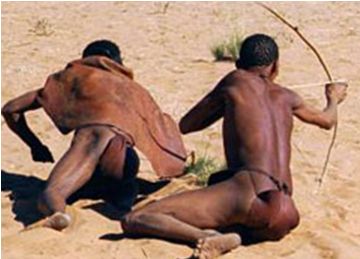 Islamic forays in to Central and West Africa were carried out between the 8th and the 15th centuries with the aim of capturing black African slaves and not primarily with the aim of converting the population to Islam. In any case, the Arab raiders could not subdue and hold any significant parts of the heavily forested territories of Central and Western Africa for long. It was also these slave traders who contributed a bulk of the Slaves to the European Slave traders from the 16th up to the 19th centuries.
Islamic forays in to Central and West Africa were carried out between the 8th and the 15th centuries with the aim of capturing black African slaves and not primarily with the aim of converting the population to Islam. In any case, the Arab raiders could not subdue and hold any significant parts of the heavily forested territories of Central and Western Africa for long. It was also these slave traders who contributed a bulk of the Slaves to the European Slave traders from the 16th up to the 19th centuries.
The point is that most of these Islamic forays in to Central and West Africa were carried out between the 8th and the 15th centuries with the aim of capturing black African slaves and not primarily with the aim of converting the population to Islam. In any case, the Arab raiders could not subdue and hold any significant parts of the heavily forested territories of Central and Western Africa for long. It was also these slave traders who contributed a bulk of the Slaves to the European Slave traders from the 16th up to the 19th centuries. These African slaves were nominally Muslims, and the Arab slave traders had no qualms in capturing their Muslim (albeit nominally so) co-religionists and transporting them bound and chained to the clutches of the European slave traders to be pushed on to the slave ships that lay in anchor at the ports of Accra and Abidjan along the coast of West Africa. Incidentally the name for the town Abidjan is derived from the Arabic term "Abeed" which means black.
The autobiography of Alex Haley throws light on the Muslim origin of many African slaves: In his autobiography Alex Haley, who was the descendant of the African slaves, mentions that his forefather who was brought to the British American possessions (that later became the United States) as a slave. Kunta Kinte whom Alex refers to his forefather in the award winning novel "Roots", was a Muslim. In spite of his being a Muslim, the Arab slave traders had transported him for de-humanizing usage as a commodity to the European slave traders in the 17th century.
This is one proof that the African slaves bound for the New World were Muslims, and the Arab slave traders had no qualms in capturing their Muslim (albeit nominally so) co-religionists and transporting them bound and chained to the clutches of the European slave traders to be pushed on to the slave ships that lay in anchor at the ports of Accra and Abidjan along the coast of West Africa. Incidentally the name for the town Abidjan is derived from the Arabic term "Abeed" which means black.
The first sustained Arab invasion of Central Africa began in the 18th century to prevent Christian Missionaries from making in roads in to Tribal Africa.
The first sustained Arab invasion of Central Africa began in the 18th century. In fact this invasion itself was a result of the European incursions on the coast of Western and South Eastern Africa and the subsequent conversion of many of the African tribes of these areas to Christianity.
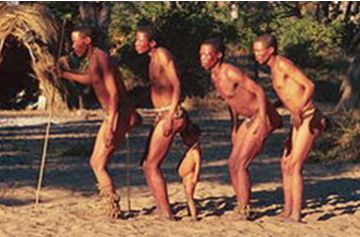 Muslim Arab slave traders who from the 7th up to the 18th century had not bothered to carry out any thorough conversion of the tribal folk of Central Africa, decided to move in after 1784 and establish a permanent rule over the tribal regions to prevent their conversion to Christianity. This fact is lost sight of by many historians.
Muslim Arab slave traders who from the 7th up to the 18th century had not bothered to carry out any thorough conversion of the tribal folk of Central Africa, decided to move in after 1784 and establish a permanent rule over the tribal regions to prevent their conversion to Christianity. This fact is lost sight of by many historians.
In fact the competing proselytization activities of the Muslim raiders and of Christian missionaries led to the drawing of fault-lines of civilization in Central Africa, Nigeria, Ghana, Southern Sudan, Northern Kenya, Tanzania, Uganda and others parts of Africa, where populations of the Muslim and Christian converts faced-off each other. There were many cases where one tribe would have adherents of both Christianity and Islam.
Why did the Muslims not convert the Central and Southern African population to Islam when they overran North Africa in 650 to 700 C.E.?
After Islam spread across North Africa in the 600s, Muslim entrepreneurs in the 8th century charted routes from oasis to oasis and realized that if large numbers of slaves were brought from below the Sahara, they could start a profitable slave trade.
Slaver caravans from Muslim regions now known as Morocco, Algeria, Tunisia, Libya and Egypt struck out on dire southward journeys. For practical reasons Muslim slavers themselves did not raid for slaves among the northernmost black tribes such as the Hausa and the Fulani. Instead they coerced the Hausa, Fulani and others to be the ones who actually dirtied their hands as slave raiders. Muslims needed only to supply the most northerly black tribes with the chains, manacles and swords they needed to efficiently kidnap people from tribes living further south.
Muslim slave traders paid the northernmost black tribes a wholesale price for those seized. Slaves surviving the long march to North African cities were sold there at retail prices. Other Muslim slavers from Arabia and Egypt sailed down the East African cost and formed a slave-gathering base on an island called Zanzibar. Equipping mainland black tribes adjacent to Zanzibar as slave raiders, they too saw their profits grow.
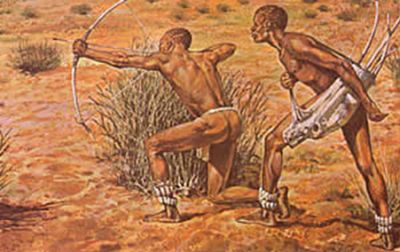 The people of Central Africa too, fiercely resisted Islam for a long time, often converting nominally to Islam and immediately reverting to their pre-Islamic animistic tribal beliefs. The first recorded Muslim invasions were as early as the 8th century, but these invasions could not make significant inroads in to the deeply forested tribal fastness of Central Africa. Many of the raids were limited to the seizure of black African slaves, who were referred to as "Abeed" which in Arabic means "Black".
The people of Central Africa too, fiercely resisted Islam for a long time, often converting nominally to Islam and immediately reverting to their pre-Islamic animistic tribal beliefs. The first recorded Muslim invasions were as early as the 8th century, but these invasions could not make significant inroads in to the deeply forested tribal fastness of Central Africa. Many of the raids were limited to the seizure of black African slaves, who were referred to as "Abeed" which in Arabic means "Black".
It was the Arab slave traders, who garnered the slave contingents bound for the Muslim Middle East. These black slaves in the Middle East have been mentioned by the Crusaders. The presence of significant numbers of black African Slaves many of and whom had their tongues cut off and were castrated, took the Crusaders by surprise.
To secure the loyalty of these black African intermediaries, the Muslim slavers brought teachers of the Koran to convert, not just any sub-Saharan black tribe, but only those that agreed to kidnap and sell their neighbors to the south. Islam thus established itself along the 4,000-mile southern edge of the Sahara form Senegal to Somalia, and among coastal tribes near Zanzibar.
Question! Why did Islam not spread much, much further across subSaharan Africa?
Alas, this is where the many historical accounts of slavery falter. Conventional history fails to even ask, let alone answer, such an intriguing question. Understandably, Islamic missionaries brought to sub-Saharan Africa by Muslim slavers could not convert more southerly African tribes. People harried by Muslim-induced slave raids were far from eager to convert to the religion of the raiders. In fact, those enterprising Muslim missionaries who ventured to convert the victimized tribes, even during times of intermittent peace, would meet vengeance.
Further, Islamic law forbids Muslims to enslave Muslims, hence converting tribes which were the source of slaves would interfere with slave-trading profits.
Christians in Europe thus unwittingly granted Islam a 1000-year head start in altering the destiny of sub-Saharan Africans. Yet Muslim missionaries, by siding with Muslim slavers instead of opposing them, forfeited the enviable advantage that 1000-year head start afforded. Had they opposed slavery instead of condoning it, Muslim missionaries could have spread Islam all the way from the Sahara to Africa’s southern tip. But history had willed otherwise. Teaching the Koran, building Mosques and founding Islamic schools with not a hint of contest from Christians, they could have Islamicized an entire continent.
Christian missionaries, arriving belatedly in the early 1800’s, would have had to struggle to win even a tiny beachhead anywhere in black Africa. Planting churches in Zimbabwe and Zululand would have been as difficult as planting churches in Algeria and Libya.
Muslims in those days little dreamed that a later century would bring scores of woefully late but zealous Christian missionaries from Europe and America to the very tribes Muslim missionaries had consigned as prey for Muslim slavers. Had such a premonition crossed Muslim minds, Islam might have ended its complicity with the slave trade industry.
All of black Africa as far as Cape Good Hope would then have been Islamicized with relative ease centuries before the first Christian incursion. Instead, though they arrived ruefully late in black African history, a relative handful of Christian missionaries have caused 250 million black Africans in sub-Saharan Africa to be categorized today as Christian!
Yes, Christian missionaries consistently opposed slavery everywhere they encountered it. In Uganda, David Livingstone often found himself looking into the muskets of Muslim slavers who were incensed at a Christian who urged them to end something they had been doing with impunity for a millennium.
The Muslim Arab slave traders who from the 7th up to the 18th century had not bothered to carry out any thorough conversion of the tribal folk of Central Africa, decided to move in belatedly after 1784 and establish a permanent rule over the tribal regions to prevent their conversion to Christianity. This fact is lost sight of by many historians.
In fact, the competing proselytization activities of the Muslim raiders and of Christian missionaries led to the drawing of fault-lines of civilization in Central Africa, Nigeria, Ghana, Southern Sudan, Northern Kenya, Tanzania, Uganda and others parts of Africa, where populations of the Muslim and Christian converts faced-off each other. There were many cases where one tribe would have adherents of both Christianity and Islam.
For instance, most of the Cape Malay tribe, have embraced the Islamic faith, while some of them have embraced Christianity. But the unifying factor for both the Muslim Malay and Christian Malay tribal folks is that they have preserved their pre-conversion Malay heritage. As against this, among the Griqua tribe most of them are Christian, predominantly converted by the Dutch missionaries, but there are Muslim pockets among the Griqua tribe too. There are many such instances across Africa.
The pre-Islamic history of Nigeria
The Muslim-Christian conflict in Nigerian cities like Kano that sometimes spills over to Ibadan, Lagos and to the capital city of Abuja is also due to differences in religion among the Nigerians all of whom are from related Negro stock.
The city of Kano is first mentioned by traders in the 10th century and was ruled by a non-Islamic clan viz., the Hausa. The pre-Islamic roots of the Hausa go to more than two hundred years before the origin of Islam, i.e. between 500 C.E. and 700 C.E. In that period the Hausa people, who had been slowly moving west from Nubia and mixing in with the local Northern and Central Nigerian population, established a number of strong states in what is now Northern and Central Nigeria and Eastern Niger. The Hausa were able to emerge as the new power in the region in around the 500 C.E. after the decline of the Nok and Sokoto (other pre-Islamic ruling clans in today's Niger and Nigeria), who had previously controlled Central and Northern Nigeria between 800 B.C.E. and 200 C.E.
The Hausa were closely linked with the Kanuri people of Kanem-Bornu (Lake Chad), the Hausa aristocracy was forced to adopt Islam by the first wave of Arabized Muslim invaders who ravaged Kano in the 11th century.
But the Hausa converts remained only nominally Muslims, in fact so very nominally, that the city was attacked once again by the Arabized Muslims who were this time led by the ethnic Fulanis in a jihad, or Holy War. Much like the way the Janjweed are today attacking the Fur Muslims of Darfur in Sudan and consider them to be infidels in spite of their being Muslims.
The population was once again forcibly re-converted to Islam in the 15th century 400 years after it had been initially converted to Islam. Its Hausa leaders were accused of having lapsed from Islam. This was typical of the conversion of the African clans to Islam. They never whole-heartedly embraced Islam, but looked upon conversion as a tactic to buy peace from their warlike Muslim tormentors.
The continuing Jihad against the Nigerians in our times
Ever since the Muslim invaders first came to Nigeria in the 11th century, the non-Muslim (animist and Christian) population has not been spared the Islamic sword.
In the 19th century, Uthman Dan Fodio launched a Jihad on this country after which Muslim have had the upper hand in victimizing Christians. Since then, the Christians have been continually living at the mercy of their Muslim neighbors.
In the North, with the full backing of local authorities, Churches are pulled down at will. The excuse? Northern Nigeria has been declared to be an Islamic State. In 1980, an Islamic-Maitatsine riot broke out there, killing 4,177 people (official figure) with millions of Naira worth of properties destroyed. The Maitatsine or Yan Tatsine (followers of the Maitatsine), a quasi-Muslim fringe group are considered to be Kafirs (infidels) by other Muslims.
In October 1982, the Islamic faithful were again destructive, setting eight big churches ablaze. In that same year, the Muslims in Kaduna went berserk, slaying 400 people (official figure). In 1984, the Islamic volcano erupted in Yola and Jimeta, killing 700 people, including some policemen, and rendered 5,913 people homeless.
In March 1987, Muslims in Kaduna, Zaria, Kafanchan and Katsina launched a half-week Jihad against Christians. In Zaria alone, all one hundred big churches were fire-bombed. Several Christians were butchered and many others were roasted to death. Many known Christian buildings were destroyed. In all those cities, any motor vehicle that displayed a Christian sticker was attacked.
In April 1991, Muslims in Bauchi went on an indiscriminate killing spree, burning down churches and destroying a great deal of personal property. About 350 people were killed. Almost simultaneously, Katsina was troubled. Ibrahim Zakari alias El-Zakzaki invaded the city with over 2,000 Shi’ite Muslim fundamentalists to help Yakubu Yahaya (his devout student) in a running battle with Colonel John Madaki, the State Governor. Lives were lost and property was destroyed.
On October 14th 1991, the Muslims in Kano went on rampage again, ostensibly to disrupt a crusade during which the German-born evangelist, Reinhard Bonnke, was to preach. They planned to murder Bonnke Himself, but mercifully they failed in this nefarious endeavor. It is difficult to arrive at the exact casualty figure there, because many of the murdered Christians were dumped in wells. However, it is estimated that over 2,000 Christians were cut down by the Islamic sword.
From this onwards, however, the Muslims, too, suffered casualties. Here are a few lines from page 16 of the Oct. 28, 1991 edition of Newswatch magazine: “But unlike in previous religious riots in which non-indigenes (people not native to the area) and Christians turned the other cheek or ran for their lives, this time they hit back. Within hours of the fundamentalists unleashing a reign of terror, the non-indigenes mobilized themselves into a militia force, brandishing cutlasses, matchets, iron rods and broken bottles in a counter attack.”
We can point out here that Jesus Christ not only told his followers to turn the other cheek, but to do so until slapped 70 x 7 times. As this incident in Kano illustrates, Christians may have reached that 70 x 7 limit! Across the world we have suffered 1,400 years of relentless assault by Muslims. Our centuries of non-resistance were not weakness, as they wrongly imagined, but in obedience to the Bible and the innate humanness which we as human beings have nurtured.
In May 1992, Zangon-Kataf, a town about 200 km south of Kaduna was destroyed, the Muslim settlers clashing with the indigenous churchgoing Kataf. The entire town was devastated and farmlands destroyed. The destruction was so total that federal authorities embarked on reconstruction and rehabilitation. Within a few days, the war spread to Kaduna.
The Muslim plan was to attack Christians during their Sunday worship services. They struck at 8 PM, local time, slaughtering people from house to house, chanting “Allahu Akbar” as they went. Many churches were set ablaze, and as usual, other Christian buildings were targeted. Thousands perished. But many Christians in Kaduna didn’t want to be slaughtered like chickens anymore. In this crisis Muslims learned that mosques burn as easily as churches, and that Muslims can die as quickly as Christians. War is an ill wind that blows no one any good!
On September 14, 1994, the Islamic faithfuls struck Potiskum, Yobe State (North East Nigeria), killing three people including an ECWA church Pastor, Yahaya Tsalibi, who was conducting communion service. Nine churches were set ablaze and 15,000,000 Naira worth of property was destroyed (Police estimate).
In Kano, on December 26, 1994, Mr. Gideon Akaluka (a Christian) was openly beheaded by a mob of Muslim faithful for allegedly defiling a portion of the Koran. They paraded his dead body around the city with his severed head paled on it, chanting a victory slogan “Allahu Akbar”.
In Sokoto, northwest Nigeria, another Christian Mr. Azubuike, was mercilessly beaten because a Muslim beggar who asked of alms accused him of insulting the prophet Muhammad. Mr. Azubuike was more fortunate than most; he was thought dead and abandoned. July 1-7, 1995, Muslims attacked Sayawa Christian community of Tafawa Balewa, Local Govt. Area, Bauchi State (northeast Nigeria). The Muslim’s first port of call was the Tafawa Balewa central market, which they set ablaze. They burned down the home of the late Mr. Bukata Adamu who had lost the rest of his family to a similar riot in 1991. The Muslims then proceeded to attack and burn down 30 Sayawa Christian villages. Over 1,000 homes were razed in this inferno. Christians were killed by the thousands. Seventy-seven churches were burnt to the ground. Properties worth millions of Naira were destroyed.
Not even women and children were spared in this genocidal Jihad – the Islamic faithful slaughtering 36 women and children who had taken refuge at a church building in a village named Gungu-Zango. The women even had their bellies ripped open!
In a village called Bununu, in Bula district, which is not inhabited by the Sayawas, twenty-two school children (ages 11 to 16 years) were trapped and butchered by Muslims. Wouldn’t you think the police or military would come to the rescue of these defenseless people? Not a chance, and no Muslim ever stood before a court of law to answer for the numerous acts of vandalism, not to mention the countless murders they committed in Bauchi State.
Instead, Sayawa Christians, the victims of that Jihad, had to stand trial before a military tribunal for causing of the trouble. By true Islamic law, it is not only permissible but laudable to lie, cheat, steal and even murder all those who are not Muslims! Islamic terrorists will not depart from their stated intent of forcibly converting or murdering non-Muslims across the globe till they are themselves eliminated all over this planet. Only that can lead to the salvation of Nigeria... and of the rest of the world
How the Jihad against the animist tribals of Darfur began in 1784
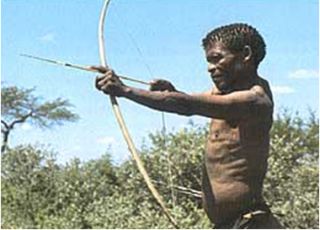 The sustained Muslim invasion and permanent occupation of African tribal lands began after the 1784 by the Mamluks (Mameluks) invasion of Central Africa. This invasion led to the conversion of many of the tribes, which included the Fur tribe of Darfur (from Dar = home), along with the tribes of adjoining Chad, Central Africa up to Northern Nigeria, Mauritania and Ghana in the West and up to Northern Kenya, Tanzania and Uganda in the South. These conversions happened as late as the 19th century.
The sustained Muslim invasion and permanent occupation of African tribal lands began after the 1784 by the Mamluks (Mameluks) invasion of Central Africa. This invasion led to the conversion of many of the tribes, which included the Fur tribe of Darfur (from Dar = home), along with the tribes of adjoining Chad, Central Africa up to Northern Nigeria, Mauritania and Ghana in the West and up to Northern Kenya, Tanzania and Uganda in the South. These conversions happened as late as the 19th century.
The descendants of these late African converts to Islam are today's darker-skinned tribesmen of Darfur (and Chad, Mauritania, Nigeria, Ghana) who were forcibly converted to Islam late in the 18th century when Areadi Gaya, the ruler of Futa Bandu State in West Sudan was forced to embrace Islam after he was defeated by the Mameluks of Egypt in 1764.
Subsequently the Mameluks led proselytising campaigns deep in to Central Africa up to Northern Nigeria and today's Ghana in West Africa. These converts still practice a mix of animism and Islam. While most of them in Northern Nigeria, Ghana, and other parts of Central Africa are insulated from Arab tyranny, those in Mauritania, suffer tyranny, that is a mostly unreported, in the form of slavery that is imposed upon them by the relatively lighter skinned Arabized Muslims of Algeria and Morocco who have migrated from the Mediterranean coast.
________________________________
The converts in Darfur and Chad are even more unfortunate. They had reverted to animism after their forced conversion in 1784, and were Muslims only in name till more than a century after their conversion. Even today they practice animism mixed with Islam, do not speak Arabic and their womenfolk do not use the Hijab, but wear colorful African traditional tribal dresses. This is seen among all African Muslim converts in Nigeria, Kenya, Tanzania, Ghana, etc.
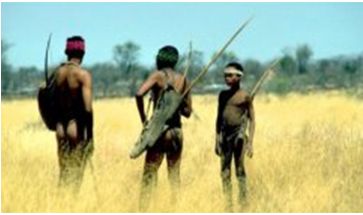 These black African Muslim converts continue to bear the brunt of the onslaught of Islam. The sufferings of the people of Darfur and Chad at the hands of the Arabized Janjweed is but one example.
These black African Muslim converts continue to bear the brunt of the onslaught of Islam. The sufferings of the people of Darfur and Chad at the hands of the Arabized Janjweed is but one example.
These Africans suffered the first wave of Arabization when Othman Dan Fodio established Islamic State of Sokoto in Central Sudan in 1804 and led raids across different parts of Central Africa to reconvert the Abeeds (blacks) who in his view had lapsed out of Islam. These attacks were the precursor of the Janjaweed attacks of today.
But in spite of these efforts, the people of Central Africa were never fully Arabized, due to their late conversion and continuing resistance to Arabization. They inhabit what is today the belt stretching from Darfur in Western Sudan through Chad, Mauritania, up to Ghana and Northern Nigeria up to Northern Kenya, Tanzania and Uganda. But the conflit is stark only in Darfur where this struggle is publicized due to their being constantly subjected to attacks from the Janjaweed who are the Arabized Muslims of Northern Sudan who consider the African black Muslims to be infidels by virtue of their being non-Arabized.
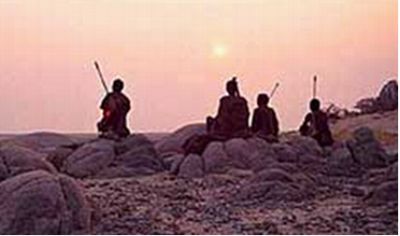 As we have noted above, before Islam destroyed them, there were developed black African civilizations like those of Benin, Ashanti, Zulu, Nubia, Axum and many others. These Black African kingdoms that existed in africa prior to the islamic invasion were culturally spiritually and technologically more advanced than the arab barbarians that invaded them as is evident from the pictures of the kings of Benin. Seen on this copperplate are weapons used by the kingdom of Benin, Nigeria circa 1550. This also proves the development of smelting in pre-Islamic Africa.
As we have noted above, before Islam destroyed them, there were developed black African civilizations like those of Benin, Ashanti, Zulu, Nubia, Axum and many others. These Black African kingdoms that existed in africa prior to the islamic invasion were culturally spiritually and technologically more advanced than the arab barbarians that invaded them as is evident from the pictures of the kings of Benin. Seen on this copperplate are weapons used by the kingdom of Benin, Nigeria circa 1550. This also proves the development of smelting in pre-Islamic Africa.
So one should not form any generalized impression of all black Africans as primitive bushmen. Before the coming of Islam destroyed or marginalized these kingdoms, there were many kingdoms like those at Benin and Ashanti. The Zulu kingdom, although more to the south also represents the independent development of civilization in ancient Africa.
__________________________________
The Challenge of Boko Haram
Boko Haram (literally, Western or non-Islamic education is a sin, from Boko and Haram) is a Nigerian militant Islamist group that seeks the imposition of Shariah law throughout all 36 states of Nigeria.
The group was founded in 2002 in Maiduguri by Ustaz Mohammed Yusuf. In 2004, it moved to Kanamma, Yobe State, where it set up a base called "Afghanistan", used to attack nearby police outposts, killing police officers. Yusuf is hostile to democracy and the secular education system, vowing that "this war that is yet to start would continue for long" if the political and educational system was not changed.
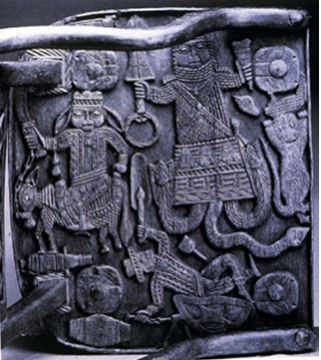 In Bauchi the group was reported as refusing to mix with local people. The group includes members who come from neighboring Chad and speak only Arabic.
In Bauchi the group was reported as refusing to mix with local people. The group includes members who come from neighboring Chad and speak only Arabic.
Boko Haram opposes not only Western education, but Western culture and modern science as well.[9] In a 2009 BBC interview, Yusuf stated that the belief that the world is a sphere is contrary to Islam and should be rejected, along with Darwinism and the theory that rain comes from water evaporated by the sun.
Recently security forces in northern Nigerian battled the remnants of an Islamic sect loosely modeled on Afghanistan's Taliban movement, following days of unrest which have killed more than 1000 people.
Members of Boko Haram -- have attacked police stations and government buildings as well as rampaging through residential areas armed with home-made guns, petrol bombs, machetes and knives in four states in northern Nigeria.
Nigerian police have claimed the killing of Mohammed Yusuf, the leader of Boko Haram while in detention.
Isa Azare, spokesman for the police command in the northern city of Maiduguri announced that Yusuf, blamed for violence that killed hundreds of people in northern Nigeria, was shot dead following his capture in August 2009.
Boko Haram represents the new challenge of Islam to the secular fabric of Nigeria. Through Boko Haram, Al Qaeda is wanting to sink its tentacles into the oil revenues that this oil rich nation generates.
________________________________
The lessons from the continuing suffering of the black African Muslims at the hands of the Arabized lighter skinned Muslims of which only Darfur is in the limelight, is that the sneaky and ruthless tactics of the Muslims can only be outmatched by we being more sneaky and ruthless ourselves. The old English adage "Everything is fair in love and war" holds greatest relevance while battling the Muslims. The only way out is give the defeated Muslims a choice of abandoning Islam and embracing any other religion or getting purged in an exercise that ends in their mercy killing. And only when we in the Non-Muslim world realize this and go into an overreach with subterfuge against the Terrorists (all of whom are Muslims), and use our still prevailing (but fast closing) edge of superior weapons against the enemy, can Islam finally be defeated and eliminated in the looming Third World War.
_____________________________________
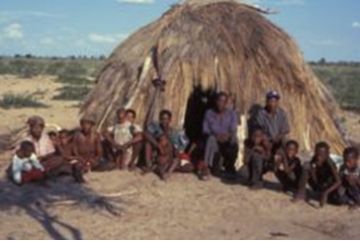 Lessons from the struggle of black Africans against Islam
Lessons from the struggle of black Africans against Islam
The lessons from the continuing suffering of the black African Muslims at the hands of the Arabized lighter skinned Muslims of which only Darfur is in the limelight, is that the sneaky and ruthless tactics of the Muslims can only be outmatched by we being more sneaky and ruthless ourselves. The old English adage "Everything is fair in love and war" holds greatest relevance while battling the Muslims. The only way out is give the defeated Muslims a choice of abandoning Islam and embracing any other religion or getting purged in an exercise that ends in their mercy killing. And only when we in the Non-Muslim world realize this and go into an overreach with subterfuge against the Terrorists (all of whom are Muslims), and use our still prevailing (but fast closing) edge of superior weapons against the enemy, can Islam finally be defeated and eliminated in the looming Third World War.
------
Select Bibliography
- The Mummy, Funeral Rites & Customs in Ancient Egypt, by Ernest A. Wallis Budge, reprint of 1893 edition by Senate Studio Editions 1995
- The Twilight of Ancient Egypt, First Millennium B.C.E., by Karol Mysliwiec, translated by David Lorton, Cornell University Press2000
- Egypt in The Age of Cleopatra, by Michel Chauveau, translated by David Lorton, Cornell University Press, 2000
- Women in Ancient Egypt, by Gay Robins, Harvard University Press, 1996
- Women and Society in Greek and Roman Egypt: A Source Book by Jane Rowlandson, Cambridge University Press, 1998
- The Chronicle of John Coptic Bishop of Nikiu (circa 690 A.D.), translated by Robert Henry Charles, reprint from 1916 edition, APA-Philo Press Amsterdam, Holland
- The Vanished Library, A Wonder of The Ancient World, by Luciano Canfora, University of California Press
- The Story of The Church of Egypt, Volumes I and II, by Edith L. Butcher, reprint of 1897 edition by AMS Press Inc, New York, N.Y 1975
- Coptic Egypt, by Murad Kamil, Le Scribe Egyptien, 1968
- Traditional Egyptian Christianity, A History of the Coptic Church, by Theodore. Hall Patrick, Fisher Park Press, 1999
- Muslim Extremism in Egypt, The Prophet and the Pharaoh, by Gilles Kepel, University of California Press 1993
- Ancient Egyptian Culture, published by Chartwell Books, Edison, N.J. 1998.
- Samson Blinded: A Machiavellian Perspective on the Middle East Conflict, by Obadiah Shoher
- Jihad in the West: Muslim Conquests from the 7th to the 21st Centuries (Hardcover) by Paul Fregosi
- The Sword of the Prophet: History, Theology, Impact on the World by Srdja Trifkovic
- Islam Unveiled: Disturbing Questions About the World's Fastest Growing Faith by Robert Spencer
- Studies in Muslim Apocalyptic (Studies in Late Antiquity and Early Islam) by David Cook
- Why I Am Not a Muslim by Ibn Warraq
- Onward Muslim Soldiers by Robert Spencer
- Eurabia: The Euro-Arab Axis by Bat Ye'Or
- Islam and Dhimmitude: Where Civilizations Collide by Bat Yeor
- What the Koran Really Says: Language, Text, and Commentary by Ibn Warraq
- Islam and Terrorism: What the Quran Really TeachesAbout Christianity, Violence and the Goals of the Islamic Jihad by Mark A. Gabriel, Mark A. Gabriel
- A Concise History of the Crusades by Thomas F. Madden
- The Politically Incorrect Guide to Islam (and the Crusades) by Robert Spencer
- The Great Divide: The failure of Islam and the Triumph of the West by Marvin Olasky
- The Myth of Islamic Tolerance: How Islamic Law Treats Non-Muslims by Robert Spencer
- Islam Unveiled: Disturbing Questions About the World's Fastest Growing Faith by Robert Spencer, David Pryce-Jones
- The Koran (Penguin Classics) by N. J. Dawood
- Don't Keep me Silent! One Woman's Escape from the Chains of Islam by Mina Nevisa
- Christianity And Islam: The Final Clash by Robert Livingston
- Holiest Wars : Islamic Mahdis, Their Jihads, and Osama bin Laden by Timothy R. Furnish
- The Last Trumpet: A Comparative Study in Christian-Islamic Eschatology by Samuel, Ph.D. Shahid
- Unleashing the beast: How a fanatical islamic dictator will form a ten-nation coalition and terrorize the world for forty-two months by Perry Stone
- Contemporary Muslim Apocalyptic Literature (Religion and Politics) by David Cook
- Islam and the Jews: The Unfinished Battle by Mark A., Ph.D. Gabriel
- The Challenge of Islam to Christians by David Pawson
- The Prophetic Fall of the Islamic Regime by Glenn Miller, Roger Loomis
- Prophet of Doom : Islam's Terrorist Dogma in Muhammad's Own Words by Craig Winn
- The False Prophet by Ellis H. Skolfield
- The Approach of Armageddon: An Islamic Perspective by Muhammad Hisham Kabbani
- The Cube and the Cathedral: Europe, America, and Politics Without God by George Weigel
- Infiltration : How Muslim Spies and Subversives have Penetrated Washington by Paul Sperry
- Unholy Alliance : Radical Islam and the American Left by David Horowitz
- Unveiling Islam : An Insider's Look at Muslim Life and Beliefs by Ergun Mehmet Caner
- Perfect Soldiers : The Hijackers: Who They Were, Why They Did It by Terry McDermott
- Islam Revealed A Christian Arab's View Of Islam by Anis Shorrosh
- Leaving Islam: Apostates Speak Out by Ibn Warraq
- The Origins of the Koran: Classic Essays on Islam's Holy Book by Ibn Warraq
Articles on this page have been posted upon agreement with the History of Jihad website administrators.
The History of Jihad site is brought to you by a panel of contributors. This site is coordinated by Robin MacArthur with Mahomet Mostapha and Naim al Khoury, New Jersey.
Other contributors to this site include professors and members of the faculty from the Universities of Stanford and Michigan (Ann Arbor), Kansas State University, Ohio State University, and the London School of Economics. We strongly suggest that this site be recommended as additional reading for students of Islamic History.
History of Jihad is against all forms of fanaticism – religious and non-religious. But the emotional appeal of non-religious fanaticism like Nazism, Fascism or Communism is not as pervasive as that of the religious fanaticism. When fanaticism and religion are mixed, we have a very potent and dangerous brew that can sustain itself for centuries unlike non-religious fanaticisms like Nazism and Communism which die out when the ringleaders are defeated.
While all forms of religious fanaticism are negative, Islam is the most vicious and the most pressing danger we face today. This site is dedication to expose the danger of Islam. We support other people taking similar efforts against other religion posing smaller threats.



Aucun commentaire:
Enregistrer un commentaire